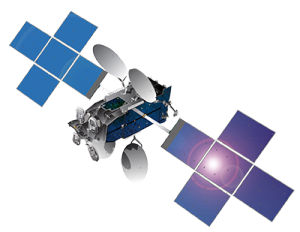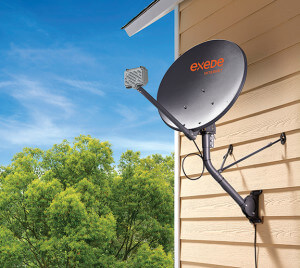
Satellite broadband company ViaSat (the company behind consumer brands Exede and WildBlue) yesterday announced plans for its third generation satellite network.
The new ViaSat-3 design will have an amazing Terrabit/second of total network capacity, which should be capable of providing "100+ Mbps broadband to any home" with support for 4K ultra-high-definition video streaming, and even faster gigabit speeds to commercial clients.
The amazing thing - each of the planned three ViaSat-3 satellites will have more raw data capacity than ALL commercial satellites currently in orbit - combined!
But you'll have to wait a while to get at it.
ViaSat's Past, And Future

ViaSat has been a leader in high capacity geosynchronous satellites since 2011, when it launched ViaSat-1 with an overall capacity of 140Gbps, way more capability than other satellites at the time.
In addition to serving corporate clients and enabling airborne Wi-Fi on commercial jets - ViaSat's consumer-focused Exede division used the capacity of the ViaSat-1 to roll out "virtually unlimited" 12Mbps satellite internet service to consumers in 2014, with very aggressive initial pricing and plan offerings.
But the spot beam technology used by Exede meant that professional fixed-location installation was required, and service could not be taken on the road in any fashion - disappointing nomads excited by the prospects of a next generation satellite plan.
ViaSat's next satellite, ViaSat-2, has been delayed until early 2017 - but when it launches it will offer 350Gbps of total capacity, more than doubling what ViaSat-1 can provide.
And now ViaSat-3 is on the horizon with a jaw-dropping 1,000Gbps capacity - but the first of the three planned ViaSat-3 satellites is not scheduled to launch until late 2019 or early 2020, meaning that we all have a long time to wait before this incredible one-terabit service is parked above us.
Maybe by then ViaSat will have figured out a way to offer support to mobile users.
But seeing as LTE is able to deliver over 100Mbps in a lot of places today, I expect by 2020 even this latest advancement in satellite technology will remain primarily of interest in places well beyond cellular coverage maps.
RV Satellite Options Today
There are options available for getting satellite-powered internet on the road - and two new ones debuted in 2015.
In July 2015, commercial satellite gear provider Mobil Satellite Technologies announced the RV DataSAT 840 - a new consumer-focused satellite internet terminal, designed specifically for RV roof mounting.
And in August satellite service reseller Real Time Communications (RTC) caught everyone by surprise by announcing something once thought exceedingly improbable - spot beam HughesNet based satellite service, with mobility support, which is now also offered with RV-friendly support from MobileInternetSatellite.com.
If HughesNet is willing to let mobile consumers "change spots" and relocate service, perhaps someday Exede will as well.
Our chapter on Satellite Internet has been completely updated for the 2016 Edition of The Mobile Internet Handbook:
RV Satellite Internet Options – Past, Present, and Future
(advanced preview available for members)








 Mobile Internet Resource Center (dba Two Steps Beyond LLC) is founded by Chris & Cherie of
Mobile Internet Resource Center (dba Two Steps Beyond LLC) is founded by Chris & Cherie of